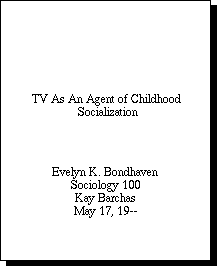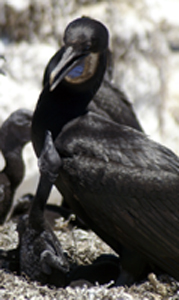 Figure 1. Sample title page. |
 Figure 2. First page of a paper without a title page. |
 Brandt's cormorant chicks ©CLCase |
Christine L. Case, Ed.D.
Biology Professor
Skyline College
Write about the topic in your own words based on information obtained from your references. Plagiarism (copying someone else's work) is strictly forbidden. Do not quote the work of ohers—use you own words and document your sources as described below.
Developed by K. Barchas, C. Case, P. Hennings, K. Mills, C. Rombaunis
1. Key text on a computer in a 10 or
12 point nonscript font such as Helvetica (san-serif) or Times (serif).
2. Print on unused, white, 20-pound, 8½ x 11 inch white paper.
3. Be sure print is dark. Do not use boldface type.
4. Use 1 to 1¼ inch left and right margins; 1 inch top and bottom margins.
5. Use your own words. Generally in science writing information is paraphrased and not quoted verbatim. Remember, this is your report and other authors are not receiving the grade. The exception is if something is especially unique and must be quoted.
6. Double line space except works cited page and quotes over 40 words which should be indented ½ inch from the left and right; always include a citation and page reference after a quote.
7. Begin each paragraph with a ½ inch tab (indentation). Single space after punctuation such as comma or period.
8. If you use a title page: include the title of the paper, your name, course, professor's name. and date (Figure 1).
9. If you do not use a title page include this information in the top left of the first page of your paper and center the title about 3 inches down as shown in Figure 2.
10. Each page after the title page should be numbered in the upper right corner with a short title and page number. E.g., Style sheet-1.
11. Do not use a folder or binder, staple pages in the upper left hand corner.
12. Italicize or underline scientific names and the titles of books, pamphlets, poems, plays, movies, TV programs, paintings, sculpture, musical works, magazines, and newspapers.
13. Use quotation marks for shorter musical works such as individual song titles, articles, short stories, book chapters, essays, episode of a TV series, songs or a section of a musical work or play.
14. Use a spell checker and proofread your paper.
Symbols
Use the correct scientific symbols or Greek letters when needed, do not
write out terms such as degrees Celsius or beta, use °C or b. Your
computer and word processing application have the necessary symbols. Ask
your instructor if you can't find them.
Using figures (pictures, graphs, and tables)
When you include figures, use words to direct the reader to figures and
summarize the important point(s) of the figure. Number and write a legend
(or description) for each figure (see figures 1 and 2).
Documenting references
You are encouraged to read all the available information on the topic
for your paper. To select appropriate references, you must evaluate your
sources of information. Print and electronic encyclopedias and dictionaries
are often good to get familiar with a topic: however, these are not
appropriate references for a research paper. The most reliable
information is that published in peer-reviewed journals.
Peer-reviewed means that the author's work has been read and accepted by colleagues in his/her discipline. The Internet has a great deal of information but most of it is not peer-reviewed and requires caution when you use it. Most government (.gov) sites are appropriate. As are the few peer-reviewed journals available online (such as publications from the American Society for Microbiology).
You must cite your sources if the information is not common knowledge. Use documentation format for citing references within the text; do not use footnotes or endnotes. When you are using ideas from someone's work, give credit to the author(s). Use parentheses, and indicate the number of the reference, the number refers to your Literature Cited page, (1) or for two references on the same information (4, 8). An alternative in writing is to use the author's name in the text: According to Smith (6), ... or According to Smith and Jones (7). Always keep author names in the order in which they appear in the source. For three or more authors, use the first author followed by et al; e.g., Smith et al (10)
Your entire list of references is listed in the Literature Cited section. List only those references you have actually read and referenced in your paper. References are alphabetical, numbered, single-spaced with hanging indentation as shown on the reverse of this sheet. Do not separate your references into categories. References should be alphabetized by author's last name.
If you need examples of other types of citations, see the references marked with an asterisk (*).
Book, pamphlet |
*Pechenik, J. A. 1993. A Short
Guide to Writing About Biology, 2nd ed. New York NY: HarperCollins. *Anson, C. M. and R. Q. Schwegler. 1997. The Longman Handbook for Writers and Readers. Menlo Park CA: Addison Wesley Longman.
|
Journal or magazine article |
Smith, J. and L. Jones. 1996. "How
to write good term papers." Scholastic Journal 34:113-146. |
Essay or Short Story from a Book |
Walker, A. 1993. "Everyday Use." C. Davakaruni, ed. Multitude. New York NY: McGraw-Hill. |
Corporate publication |
*Council of Biology Editors, Inc. 1994. CBE Style Manual, 6th ed. Bethesda MD; Council of Biology Editors, Inc. |
Laboratory manual |
Case, C. L. and S. Snitovsky. 1997. Investigations in Biology, Biology 215 Laboratory Manual. "Digestive Enzymes," pp. 33-41. San Bruno CA: Skyline College. |
Class handout |
Lambert, R. 1997. "Magnitude Measurement." GEOL 210. San Bruno CA: Skyline College. |
Newspaper, |
(This
article is in a special section and not on sequential pages. Start with the title of the article to cite an unsigned
article.) |
| Electronic sources, CD ROM, floppy disk
|
*Seward, D., M. Hairston, and J. Ruszkiewicz. 1997. CoreText Online. Menlo Park CA: Addison Wesley Longman. [Diskette].
|
Unpublished interview (including email, class lecture, a classmate, or a study group) |
Berg, P. Email to the author. 17 October 1997. |